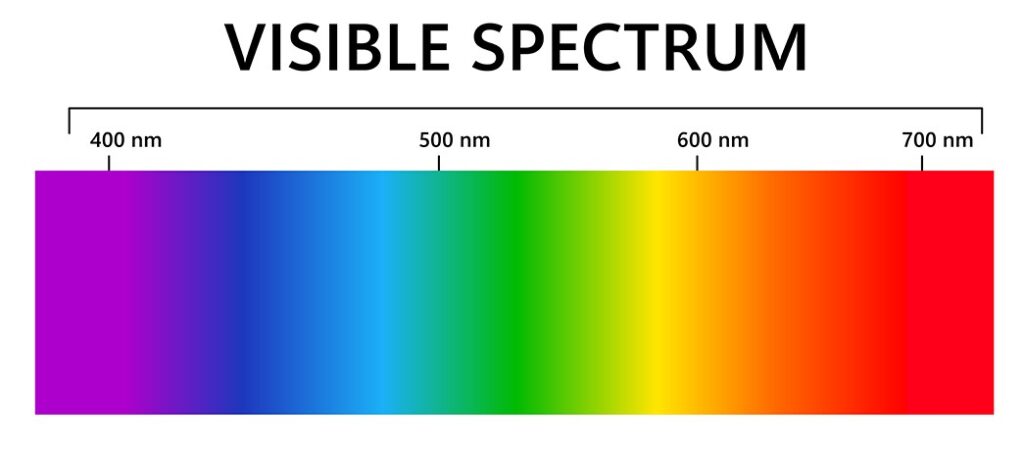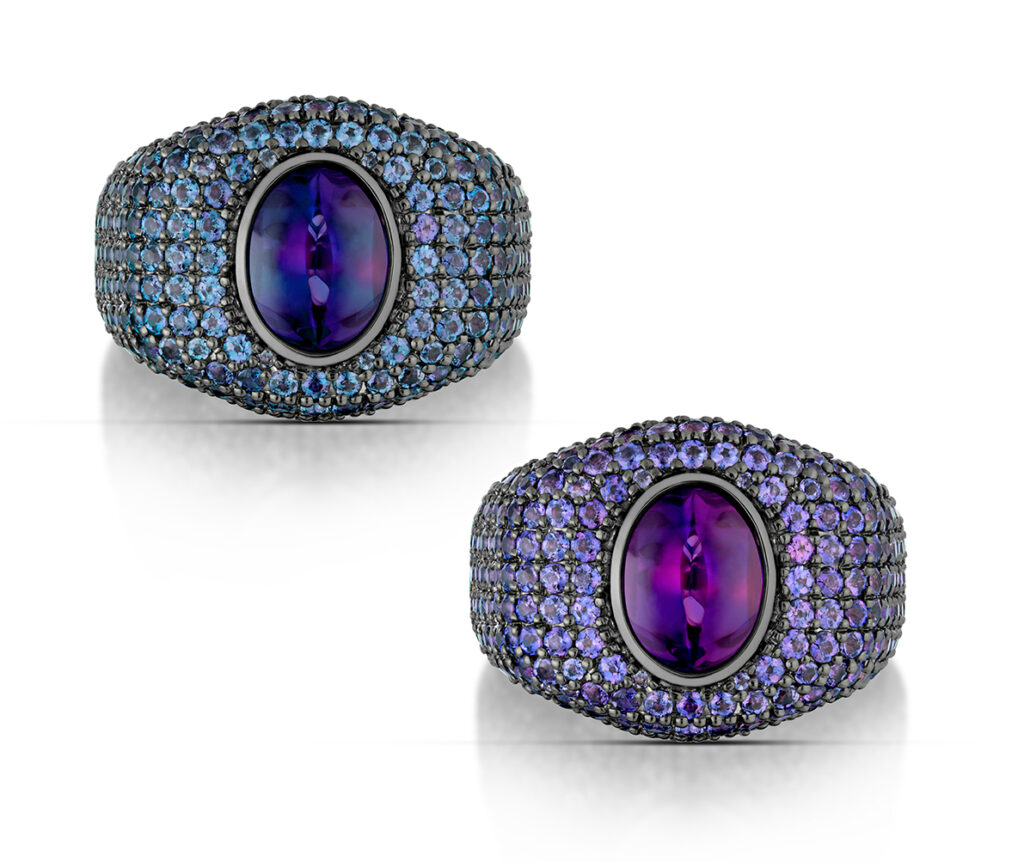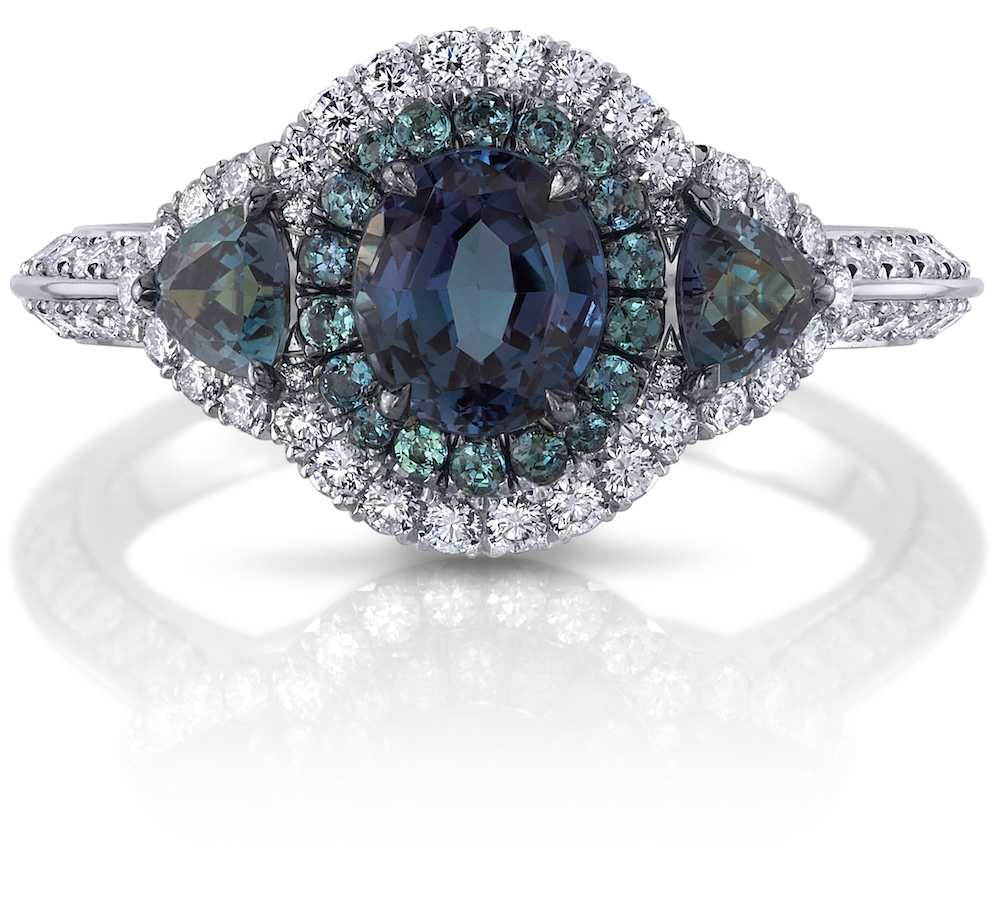FYI- SPONSORED CONTENT
THE CAPTIVATING PHENOMENON OF COLOR-CHANGE GEMSTONES
Wade Abel, CG, Director of Gemology, American Gem Society

Platinum earrings
2.94 carats of Alexandrite, two hexagon-cut & numerous round diamonds.
AG Gems
Seeing something change colors right before our eyes can seem magical! Combining that “magic” with the allure and beauty of gemstones is captivating. This phenomenon of color change can be found in color-change gemstones, prized for their ability to shift hues when viewed under different lighting conditions. Two of the most sought-after colorchange gemstones are alexandrite and color-change sapphire. Before learning about the individual gemstones, it’s important to understand the mechanism behind the color change phenomenon.
The Science of Color Change
This optical effect occurs due to the way gemstones absorb and reflect light, particularly across different wavelengths. The visible spectrum of light contains varying wavelengths. Cool light is from the shorter violet and blue wavelengths and warm light is from the longer red and orange wavelengths.
The color change phenomenon results from a gem’s specific chemical composition, which can include trace elements like chromium or vanadium. These elements influence how light is absorbed or reflected. When a gemstone shifts color, it’s because it reacts differently to light sources based on the different temperature wavelengths. Cool light, like that from fluorescent or daylight, contains blue and green wavelengths, resulting in the cooler hue appearance of the gemstone. Warm light, like incandescent bulbs or candlelight, contains more red and yellow wavelengths and results in a warmer hue.

Alexandrite: The Ultimate Color-Change Gemstone
Alexandrite is perhaps the most famous color-change gemstone, often described as “emerald by day, ruby by night.” This remarkable stone was first discovered in the Ural Mountains of Russia in 1830 and was named in honor of Tsar Alexander II. Today, significant alexandrite deposits are also found in Brazil, Sri Lanka, and East Africa, particularly Tanzania.
Under daylight or fluorescent lighting, alexandrite typically appears green to blue-green. However, under incandescent lighting, it transitions to red or purplish-red. This color shift is caused by the presence of chromium in the gemstone’s atomic structure, which allows the stone to absorb both blue-green and red light. The balance between these wavelengths’ shifts depending on the light source, leading to a striking change in color. High-quality Alexandrite displays an intense, dramatic color shift.

Award-winning platinum men’s ring
– 2.35 ct. oval alexandrite & 3.07 ct.
total weight of 206 round alexandrite.
Omni Prive
Color-Change Sapphire
Though sapphires are best known for their blue hues and can come in many other colors, color-change sapphires are a rare and beautiful variety that deserves attention. These gems exhibit a color shift that is less pronounced than alexandrite but still captivating. They are typically sourced from Sri Lanka, Madagascar, and Tanzania.
In daylight, color-change sapphires usually appear blue to bluish-violet. Under incandescent lighting, however, they often show a purplish or reddish hue. The color-change effect in sapphire is generally caused by the presence of trace amounts of vanadium or chromium. While they may not have a color change that is as dramatic as alexandrite, high-quality colorchange sapphires still make a striking impression due to their rarity and beauty.
Presentation of Color-Change Gemstones
When working with color-change gemstones, it’s important to understand how to best present them. First and foremost, lighting is key. Ensure that your customers see the gemstone under multiple lighting conditions to fully appreciate its colorchange effect. This can be done by switching between daylight, fluorescent, and incandescent lighting and provides an exciting and interactive experience.
When discussing the value of color-change gems, stress the importance of the strength and distinctiveness of the color shift. Stones that exhibit a more pronounced and dramatic change are typically more valuable, especially if their base colors (such as green to red in alexandrite) are particularly vibrant and saturated.

Award-winning platinum men’s ring
– 2.35 ct. oval alexandrite & 3.07 ct.
total weight of 206 round alexandrite.
Omni Prive
Conclusion
Color-change gemstones offer an exceptional optical experience with their ability to shift hues depending on the lighting conditions. Alexandrite, color-change sapphire, and color-change garnet each present their own unique beauty, driven by complex chemical compositions that interact with light in fascinating ways. Understanding the science behind these phenomena and showcasing these gems under the right lighting will enhance your ability to convey their beauty and rarity and share the “magic” of color change!
American Gem Society (AGS) members must adhere to a Code of Ethics that helps increase customer confidence in their shopping experience. AGS titleholders have professional credentials that prove they are up to date with industry developments and regulations because they must recertify annually with education and an exam. Overall, it comes down to understanding the guidelines that need to be followed and a knowledgeable sales team that can incorporate clear, accurate, and honest communication to help inform the customer. This promotes consumer protection and integrity in the industry and helps customers appreciate their purchase.




